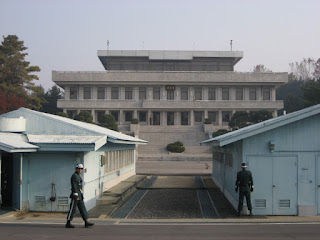DMZ: In front of them all

Facing North Korea from the South Korean side of Panmunjeom, UN village between the two Koreas. The soldiers patrolling in the foreground are South Korean, but, if you look really closely, you can see a North Korean guard by the front door.
The Korean War armistice defined a military demarcation line (roughly, but not quite, the 38th parallel) that divides the Korean peninsula into North and South. The 2.5 mile area that surrounds this border line and runs coast to coast is called the demilitarized zone or DMZ - a buffer zone where no troops are allowed. Ironic, then, that the DMZ is considered the most heavily fortified border in the world. (doubly ironic, fun fact: it's also a terrific nature reserve because of the lack of human interference over the past 60 years...well, minus the land mines that are still rife throughout the DMZ, it would be more terrific!).

Where things lie.
Seoul is remarkably close to the demilitarized zone (DMZ) - only about 60 kilometers (40ish miles) - so I took the opportunity to go on a tour of the DMZ. You can only go on a tour of the area as part of an organized tour. DMZ tours are a big (and kinda creepy) tourist draw in South Korea, and so there are no shortage of tour groups. I decided to go with the USO. Maybe all tours get the same treatment, but on the USO tour we had a US Army Captain tour guide plus a South Korean "RoK" (Republic of Korea...but pronounced like "Rock!") soldier leading us around the U.N. village of Panmunjeom. Neat!

These little blue huts are right on the military demarcation line. Most of the North-South negotiations have occurred in the "neutral" ground of these trailer-like buildings in Panmunjeom. Both the North and South Korean sides are patrolled by the respective countries' soldiers, who surely must have stressful jobs!
So, for most of us in the "free" world, the Korean situation feels pretty hunky dory! 1953 was a long time ago, and South Korea is doing pretty well on all fronts (economic, social, and cultural - thanks, Samsung, Rain, and Korean soap operas!). But touring the DMZ makes you feel as if war could break out at any minute...and I suppose it could, given the fact that the war has not officially ended with a peace treaty. The South Korean RoK soldiers (and, as a matter of fact, those from the North plus the handful of US Army that remain there) thus consider themselves "in front of them all."

The reason why this guard is half-hidden behind the building is so that if a North Korean guard starts shooting at him, he at least has a good chance of having cover and time to draw his own weapon. Holy crap. I feel sorry for the one soldier (i.e., sitting duck) who stands between the two huts and has no cover at all.
There is a dress code to visit Panmunjeom (read: don't be a slob in front of the North Koreans). In case of close contact with North Korean guards, we were instructed not to wave or make funny gestures or look at them (apparently, they can use negative images of us as propaganda!!!). Tourists are not allowed to take pictures, like, anywhere. No snaps out of the bus window or even in the gift shop - you can only take pics where it is "authorized". I only got very few pictures of the day-long outing - you're basically looking at them here.

South Korea has mandatory military service for all male citizens. Apparently, the RoK soldiers assigned to DMZ (and especially Panmunjeom) duty must be tall (over 6 ft), in shape, and good (as well as tough!) looking, too. Call it intimidation factor. At least they get government-issued Ray Bans.
Some highlights of the tour included climbing down part of the Third Infiltration Tunnel. Discovered by the South in 1978, it was one of the (many!) tunnels dug by North Koreans in an attempt to attack Seoul well into the 1970s! They smeared black paint and coal on the limestone walls and said it was a coalmine!
Then there was seeing the giganto North Korean flag in a North Korean border village right across the DMZ. The thing is huge and has to be hauled down when it rains because it will rip under its own weight. Oh, and the village where it is located is a "show" village - relatively modern buildings, but no one works or lives in them.
Also, there was learning about the Axe Murder Incident of 1976 (wow, lots of things happened in the late 70's!) in which people basically died over chopping down a tree. Okay, it's more complicated than that and shouldn't be taken in such jest, but you just can't make this stuff up!

As in all things (South) Korean, there is a way of making everything - even the most intimidating and scary aspects of one's culture - look really cutesy.
The tour was super-interesting, and I'd highly recommend it if you're ever in Korea. More than anything, it makes you realized that the conflict between the two Koreas is very far from over, and maybe we should be more closer attention that we currently are.
0 Comments:
Post a Comment
<< Home